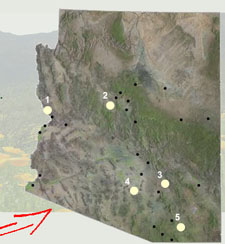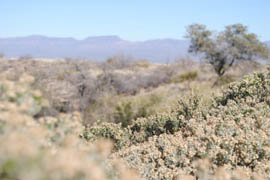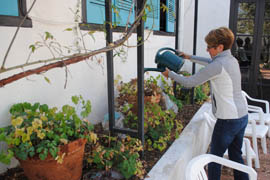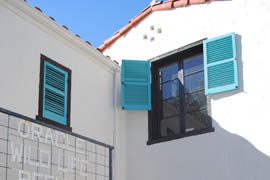Cronkite News has moved to a new home at cronkitenews.azpbs.org. Use this site to search archives from 2011 to May 2015. You can search the new site for current stories.
Back from the brink? Arizona State Parks reaches milestone
ORACLE – For the past two years, Mary Ann Pogany has been tending the Mediterranean patio gardens at Oracle State Park –not because it’s her job, but because there’s no one else to do it.
The park, a wildlife preserve and education center sprawling across 4,000 acres of quiet hills and desert oak, has been closed since late 2009, when the Legislature began cutting Arizona State Parks to help address mammoth budget deficits.
Pogany, treasurer of Friends of Oracle State Park, feels like part of the land is hers. She has written bundles of donation letters, hosted charity dinners and planned a golf tournament that raised $5,000 for the park. Her group even has an office in the park’s historic Kannally Ranch House, built in the 1920s for five siblings who had tuberculosis.
Now, thanks to $21,000 raised by Pogany’s group, Oracle State Park has reopened to the public, if only on Saturdays. And for the first time in two years, all state parks that can be open will be open.
For some, the park’s opening is a sign of recovery for Arizona State Parks, an agency that has lost $82 million since 2008 in state budget sweeps.
But others are hesitant to be hopeful, anticipating a day when money runs out again. Funding for Oracle State Park, for example, is only guaranteed for six months, February to April and September to November.
“We might have to do it again, but we can’t do this year after year,” Pogany said.
Before it closed, the park and its historic house brought in a fair stream of tourists to Oracle, an unincorporated former mining town about 40 miles north of Tucson.
“A lot of the people thought the closing would be short–lived,” Pogany said, watering a Cleveland sage. “There was a constant buzz about how sad it was. You lose part of the community when you lose a park like this.”
Arizona State Parks hasn’t received state funding since 2009, and only nine of the state’s 29 public parks have stayed consistently open throughout the budget crisis. (The agency runs 30 total properties, though one of them, San Rafael State Natural Area in southern Arizona, has never been open to the public.)
“State Parks has not had any general fund appropriations in two years. That alone is a cause for concern,” Arizona State Parks Interim Executive Director Bill Feldmeier said. “I don’t believe we’re every going to see that kind of money again.”
The agency currently works off a $19.5 million budget, Feldmeier said, but it has about $200 million in capital needs.
The Arizona State Parks Board supports HB 2362, a bill aiming to prevent more budget sweeps by allowing the agency to keep its own revenue. The bill, which was advancing in the House, was introduced by Rep. Karen Fann, R–Prescott.
“We’re looking to get the tools from the Legislature to complete our toolbox so we can fix our system and move forward,” Feldmeier said.
The interim director said he’s hopeful but realistic about the financial stability of parks, especially when it comes to state historic parks, such as Jerome and Fort Verde.
“If the economy doesn’t improve and we are unable to find new sources of revenue, then that is problematic not just to Oracle but to other parks as well,” he said.
When the parks fell in 2010, many municipalities stepped in. Payson Mayor Kenny Evans wanted to help sustain Tonto Natural Bridge State Park, but he wasn’t interested in a one–time payment that would eventually run out.
Partnering with private companies, nonprofit organizations and the Tonto Apache Tribe, Payson was able to turn Tonto National Bridge into a self–sustaining and profitable park. Today, the park attracts not only campers and hikers but also special events, weddings and family reunions.
“It’s fallen disproportionally on rural communities to ensure that these parks stay open,” Evans said. “A benefit of that is it’s forced us to do what we probably should have been doing all along.”
Diane Joens, mayor of Cottonwood, also lent her town’s resources to Dead Horse Ranch State Park, taking control of the park’s water and waste system, a value of $55,000 a year.
“We believe these are great economic engines for cities and towns,” she said. “State parks are treasures, not only to the people who live in the area but people who travel here from all over the state and country.”
Joens said she and nearby mayors began conversations with Fann that helped inspire the lawmaker, whose district is home to five state parks alone, to introduce the state parks revenue bill.
“If Representative Fann’s bill gets through and if state parks can get the funds they actually earn, budgets will still be tight, but they will be able to survive,” Joens said.










